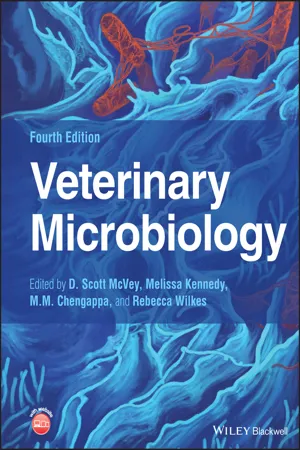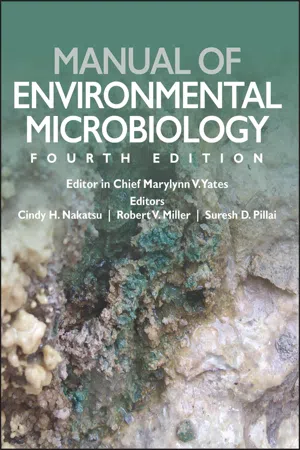Biological Sciences
Obligate Anaerobe
An obligate anaerobe is a microorganism that requires an oxygen-free environment to survive and grow. These organisms are unable to use oxygen for energy production and can be harmed or killed by its presence. Obligate anaerobes are commonly found in environments such as deep soil, sediments, and the human digestive system, where oxygen levels are low or absent.
Written by Perlego with AI-assistance
Related key terms
4 Key excerpts on "Obligate Anaerobe"
- eBook - ePub
- D. Scott McVey, Melissa Kennedy, M. M. Chengappa, Rebecca Wilkes, D. Scott McVey, Melissa Kennedy, M. M. Chengappa, Rebecca Wilkes(Authors)
- 2022(Publication Date)
- Wiley-Blackwell(Publisher)
33 Gram‐Negative, Non‐Spore‐Forming AnaerobesTiruvoor G. NagarajaAnaerobic bacteria use inorganic or organic molecules – rather than oxygen – as a final electron acceptor to generate energy for metabolism. Anaerobes are broadly categorized as obligate and aerotolerant based on the degree of susceptibility to molecular oxygen. Obligate Anaerobes are adversely affected by oxygen, and the degree of oxygen toxicity varies with species and even strains within a species. When exposed to molecular oxygen, bacteria generate powerful oxidants, such as hydrogen peroxide, superoxide anions, singlet oxygen, and other oxygen radicals. These oxygen radicals interact with cell macromolecules, such as proteins and nucleic acids, to disrupt their structures and cause lethal damage to cells. Obligate Anaerobes lack mechanisms and enzyme systems, such as superoxide dismutase and catalase, to neutralize toxic products. Gram‐negative anaerobes of clinical importance are generally aerotolerant because many of them do contain low levels of superoxide dismutase and catalase or peroxidase and can resist exposure to oxygen, but the duration of tolerance varies with species. Because of aerotolerance, many of the clinical anaerobes can be grown in culture medium that is not pre‐reduced and are able to grow on agar surfaces as long as incubation is carried out under an oxygen‐free atmosphere.A number of genera and species of gram‐negative, non‐spore‐forming anaerobes are part of the normal flora of the mucosal lining of the mouth, intestine, and respiratory, urinary, and genital tracts of animals and humans. These organisms are more often opportunistic pathogens and generally cause infections following the breakdown in mucosal or epithelial barriers and the entry of the bacteria into normally sterile sites of the body. - Randall T. Hayden, Karen C. Carroll, Yi-Wei Tang, Donna M. Wolk(Authors)
- 2016(Publication Date)
- ASM Press(Publisher)
120 Selected Topics in Anaerobic Bacteriology
INTRODUCTION
A diverse community makes up the normal healthy microbiota in humans, and anaerobic bacteria are the primary component (1 –4 ). A wide variety of different environments in the human body support complex microbial communities comprising both obligate and facultative anaerobes (3 , 4 ). At all body sites where anaerobes are part of the indigenous microbiota, Obligate Anaerobes greatly outnumber facultative anaerobes by a factor of 10 up to 1,000 times (Table 1 ) (5 –9 ). Obligate Anaerobes are therefore the predominant type of bacteria present in humans at skin and mucosal surfaces. Microbial-community analysis of healthy human intestinal microbiota also reveals a rich and diverse array of anaerobes including Lactobacillus spp., members of the former Bacteroides fragilis group (i.e., B. fragilis, B. distasonis, B. thetaiotaomicron , B. ovatus , and B. vulgatus ), other Bacteroides species, and Clostridium spp., as well as a wide array of anaerobes that are less clinically encountered (2 , 10 , 11 ). Under normal circumstances, intestinal anaerobes are not pathogenic but are essential for preventing overgrowth of opportunistic organisms or infection with pathogenic bacteria. Colonization resistance against acquisition of enteric pathogens (i.e., Salmonella and Shigella ) and hospital-acquired antibiotic-resistant bacteria (e.g., vancomycin-resistant enterococci and Clostridium difficile ) is provided by the presence of healthy normal bacteria that prevent gastrointestinal colonization by exogenous bacteria (1 , 10 , 12 –18 ).Table 1 Diversity of anaerobes in the human bodya, ba See references 5 –9 .b CFU, colony-forming units; GI, gastrointestinal.Recent microbiome studies document clearly that maintenance of the integrity of the intestinal microbiome is essential to health. These microbial communities have important immunomodulatory effects on the development and regulation of host immune function, as well as contributing to the host’s nutrition by providing nutrients and vitamins to cells (1 , 2 , 4 , 11- eBook - ePub
- Cindy H. Nakatsu, Robert V. Miller, Suresh D. Pillai(Authors)
- 2016(Publication Date)
- ASM Press(Publisher)
Anaerobic Cultivation TAKASHI NARIHIRO AND YOICHI KAMAGATA 2.1.2Anaerobes are key players in global cycles of elements and nutrition in natural and anthropologic ecosystems and are also causative agents of human and veterinary diseases. Numerous studies have sought to develop culturing techniques for anaerobes to enable the elucidation of their basic physiology, pathogenic mechanisms, and ecological functions. This chapter describes a brief history of the development of anaerobic culturing techniques from the historical Hungate technique to techniques and apparatuses commonly used in modern laboratories. In addition, recent progress in anaerobic culturing techniques (e.g., single-cell manipulation and isolation, the six-well plating method, the coculture method, bioreactor-based enrichment, and in situ /in vivo cultivation) are described, with several examples of the application of these techniques for the isolation of anaerobes from natural and artificial ecosystems.Anaerobic microorganisms (hereafter designated anaerobes) are key players in global cycles of elements (e.g., carbon, nitrogen, sulfur, and iron) in natural and anthropogenic ecosystems, including aquifer/groundwater (1 ), animal/insect guts (2 , 3 ), rice paddy fields (4 ), rumen (5 ), terrestrial/oceanic subsurfaces (6 , 7 ), wetlands (8 ), biodiesel production processes (9 ), food production processes (10 ), and wastewater treatment processes (11 ). In these anoxic ecosystems, various metabolic groups of anaerobes play roles in specific biochemical reactions, such as fermentation (12 , 13 ), anaerobic ammonium oxidation (anammox) (14 ), sulfate reduction (15 ), iron reduction (16 ), syntrophic substrate oxidation (17 ), and methanogenesis (18 ). In addition to these metabolic groups, anaerobes include human and animal pathogens, which were the main focus in the earliest era of modern microbiology. The challenges of cultivating, characterizing, and controlling these anaerobic pathogens organisms spurred the establishment of modernized microbiology (19 –23 - eBook - ePub
- Jane E. Sykes, Craig E. Greene(Authors)
- 2013(Publication Date)
- Saunders(Publisher)
Fusobacterium canifelium is common in the oral cavity of dogs and cats and has been isolated from dog and cat bite wounds in people. Unfortunately, this organism is typically resistant to quinolones, unlike the human isolates.Pathogenesis
Obligate anaerobic bacteria cannot live in healthy tissue. On certain mucosal surfaces (e.g., intestinal tract, gingival crevices, genital tract), they live with other microorganisms (facultative anaerobes) that scavenge molecular oxygen, resulting in a local environment with very low redox potential (Eh, a measure of oxygen tension). Likewise, in compromised tissue, inflammatory cells and co-inoculated aerobic microorganisms lower the E h sufficiently for anaerobes to grow. Numerous factors that predispose the body to anaerobic infections are listed in Table 39-2 .TABLE 39-2 Factors Contributing to Development of Anaerobic InfectionsPhysiologic Injury Causes Immunosuppression Cytotoxic chemotherapy Glucocorticoid therapy Malignancies Neutropenia Hypogammaglobulinemia Narrow-spectrum aerobic antibacterial therapy Diabetes mellitusAltered tissue oxygenation Vascular compromise Hypotension Tissue anoxia GI obstruction or stasis Tissue traumaTissue contamination GI or urogenital perforation Bite or puncture wounds of soft tissues Foreign body migrationGI , Gastrointestinal.Components of anaerobic bacteria have been shown to elicit potent inflammatory responses. Gram-negative anaerobes possess lipopolysaccharides with endotoxic activity, as do their aerobic counterparts. The peptidoglycan of gram-positive anaerobes incites the same inflammatory response as gram-positive aerobic microorganisms. Some anaerobic bacteria produce capsules (e.g., Bacteroides fragilis , pigmented Prevotella spp. and Porphyromonas spp.), which incite inflammatory responses that result in abscess formation; in other words, capsules without viable bacteria can also induce abscess formation.101 Some evidence suggests that co-inoculated aerobic microorganisms induce anaerobe capsule formation. Capsules also play a more traditional role by inhibiting phagocytosis.9 ,42
Learn about this page
Index pages curate the most relevant extracts from our library of academic textbooks. They’ve been created using an in-house natural language model (NLM), each adding context and meaning to key research topics.



